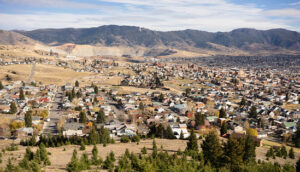In 1812, the town of Butte was little more than an assortment of mining tents. Fast-forward nearly 100 years and Butte was booming as one of the most prosperous cities in the United States. Butte ingenuity generated millions of dollars mining the Richest Hill on Earth, while creating thousands of high-paying jobs and a rich, multinational culture.
There was only one problem: Mining operations require an ample, reliable supply of energy, which in the late 1800s wasn’t exactly easy to come by. But rivers were.
As a headwaters state, Montana boasts roaring rivers, including the headwaters of the Missouri (which in turn becomes the Mississippi), Columbia and Hudson Bay basins.
Early residents decided to harness the power of these waters, and as the largest and richest city in the state at the time, Butte was at the forefront of this innovation.
Hydroelectric Beginnings:
Less than ten years after the first hydroelectric facility opened in the United States — engineers built the Black Eagle Dam in Great Falls, Montana. Shortly thereafter, the bulk of hydroelectric projects shifted to be closer to Butte and its mining operations.

A series of small power companies formed, merged, then reformed, harnessing the energy from the Madison and Missouri Rivers, two mighty bodies of water that flow within a few miles of Butte proper.
Almost all of the mining operations in Butte and nearby Anaconda ran off of this hydropower, creating a legacy you can still see in the state today. According to a 2015 U.S Energy Information Administration report, over 30 percent of Montana’s generated net electricity stemmed from hydroelectric sources, compared to 6 percent nationwide.
The Creation of the Montana Power Company:
Still, these smaller power companies could not meet the demands of the newest economic powerhouse in town — the Anaconda Mining Company. In December of 1912, the head of the Anaconda Mining Company and the president of the First National Bank in Great Falls, Montana incorporated the Montana Power Company, merging the Butte Electric and Power Company with three of its subsidiaries.
Thus the Montana Power Company owned nearly all of the power facilities within the state — the bulk of which were hydroelectric generating plants on the Madison and Missouri Rivers.
This Butte-based powerhouse continued to acquire their competitors while expanding the generating capacity of the assets they already owned. Between 1890 and 1975, Montana experienced a boom in electric power facilities that powered the entire state and beyond.
This golden era of power generation largely stemmed from Butte engineering and ingenuity — their answer to the state’s increased levels of power consumption.
The Montana Power Company thrived throughout the rest of the 20th century, expanding into the natural gas, oil, and coal sector, creating jobs across the state.
In 2000, the Montana Power Company switched gears and became the telecommunications company, Touch America. They sold their remaining assets to Northwestern Energy, whose Montana headquarters remain in Butte, the city where it all began.
Butte’s history is long, rich, and full of remarkable resilience. Its ability to be innovative in the face of challenges, like utilizing the state’s abundance of rivers to generate power, is a trademark of its history and part of what makes the city an inspiring place to do business.
In Butte, you’ll never be left in the dark.




